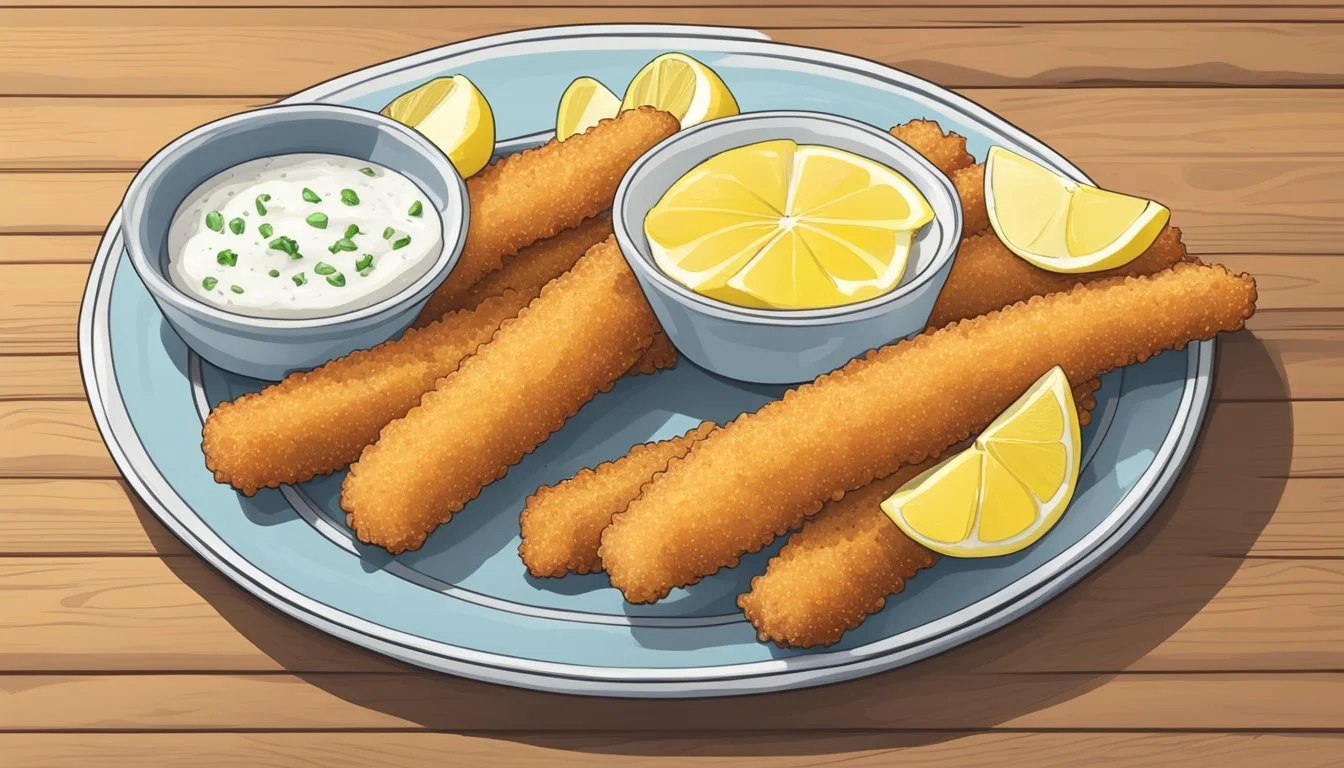Are Fish Sticks Gluten-Free?
Uncovering the Truth About This Popular Snack
Fish (What wine goes well with fish?) sticks are a popular food choice for their convenience and kid-friendly appeal, but for individuals with gluten sensitivities or celiac disease, determining whether fish sticks are gluten-free is crucial. Traditionally, fish sticks are coated with breadcrumbs or batter containing wheat flour, which contains gluten. However, with the increasing demand for gluten-free options, manufacturers have started producing gluten-free fish sticks that use alternative coatings such as rice flour, gluten-free bread crumbs, or cornmeal to cater to the needs of those avoiding gluten.
When shopping for gluten-free fish sticks, consumers should look for labels that clearly state the product is gluten-free. Products certified by a gluten-free certification organization offer additional assurance. It is also important for consumers to be aware of potential cross-contamination in facilities that process both gluten-containing and gluten-free products. For homemade gluten-free fish sticks, a variety of recipes can be found that include ingredients like gluten-free flour blends, eggs, and seasonings to achieve a similar taste and texture to traditional fish sticks.
The emergence of gluten-free fish sticks has provided a convenient and enjoyable option for those on a gluten-free diet. They can now experience the simple pleasure of this classic dish without the concern of adverse reactions to gluten. By reading labels and preparing gluten-free fish sticks at home, individuals can safely include this dish in their meal planning.
Understanding Gluten-Free Diets
Gluten-free diets are essential for individuals with gluten-related disorders, providing a necessary approach to avoid health complications. They involve careful selection of foods to prevent the ingestion of gluten, a protein that can trigger adverse reactions in certain people.
What Is Gluten?
Gluten is a family of proteins predominantly found in wheat, barley, and rye. It acts as a binding agent, giving dough its elasticity and bread its fluffy texture. Gluten consumption is harmless for most people, but it can pose significant health risks for individuals with allergies or intolerances.
Who Needs a Gluten-Free Diet?
A gluten-free diet is critical for individuals with celiac disease, a serious autoimmune disorder where ingestion of gluten leads to damage in the small intestine. It is also beneficial for people with non-celiac gluten sensitivity or a wheat allergy. These conditions trigger a range of symptoms from digestive discomfort to severe allergic reactions. Avoiding gluten is not necessarily healthier for those without a gluten-related disorder; rather, it is a medical necessity for those affected by one.
Exploring Fish Sticks
Fish sticks offer a convenient seafood snack or main course, often associated with their crunchy texture and mild taste. They serve as an approachable introduction to fish for many, drawing on the appeal of the iconic fish and chips.
History of Fish Sticks
Fish sticks, also known as fish fingers in some regions, originated in the mid-20th century. They were developed as a solution to improve the storage and longevity of fish, aiming to provide a ready-to-cook option. Their invention is attributed to creating a market for underused species of whitefish, thus providing a new revenue stream for fishermen and manufacturers.
Commercial manufacturing of fish sticks began in the 1950s, with rapid adoption in American households. They became a staple, especially favored in contexts where quick and easy meal solutions were needed, such as providing a fast dinner for children or serving as a hearty snack.
Popularity and Consumption
Fish sticks have maintained popularity due to their convenience and consistent taste. They're often marketed as a family-friendly option, suitable for both snack-time and as the key component in a main course. These breaded and fried pieces of fish are traditionally made from whitefish like cod or haddock and are known for their crispy exterior when cooked.
In terms of consumption, fish sticks can be found in the frozen section of supermarkets around the globe. Consumers typically prepare them by baking or frying, and they're frequently served with tartar sauce, ketchup, or mayonnaise-based dips, complementing their savory flavor profile. Their association with being a quick meal solution keeps them prevalent in the busy lives of many, offering the taste of seafood without the longer preparation time that cooking whole fish entails.
Ingredients of Standard Fish Sticks
Fish sticks, a popular frozen food item, typically consist of a white fish (What wine goes well with white fish?) coated with a breadcrumb mixture and seasonings. They are often prepared by being fried or baked.
Common Fish Stick Ingredients
Standard fish sticks contain a variety of ingredients, which work together to create their signature taste and texture. The primary ingredient is white fish, such as cod or pollock, which provides the protein base of the fish stick. Common seasonings include salt and pepper, which are used to enhance the natural flavors of the fish. The coating often consists of breadcrumbs, which contribute to the fish sticks' crunchiness upon cooking. Eggs and sometimes milk or buttermilk act as binding agents for the breadcrumb mixture to adhere to the fish during the coating process.
Gluten Containing Ingredients
In many cases, fish sticks may contain gluten, making them unsuitable for individuals with gluten-related disorders. Gluten is primarily found in wheat products, which are commonly used in the breadcrumbs and flour coating. Specifically, the wheat flour and seasoned breadcrumbs often contain gluten, unless stated otherwise as being gluten-free.
Breadcrumbs: Typically made from wheat, rye, or barley, which all contain gluten.
Wheat Flour: Used in the coating and batter, it is a common source of gluten.
For those requiring a gluten-free diet, it's crucial to look for fish sticks that are labeled as gluten-free, indicating that they have been made with gluten-free alternatives such as gluten-free breadcrumbs and flours.
Gluten-Free Fish Stick Alternatives
For individuals with celiac disease or gluten sensitivity, finding gluten-free fish sticks is essential. Fortunately, one can opt for commercial brands that offer gluten-free versions or can create homemade fish sticks with the right gluten-free ingredients.
Commercial Gluten-Free Fish Sticks
Several brands have recognized the need for gluten-free alternatives and offer fish sticks that are safe for a gluten-free diet. These products typically utilize gluten-free coatings made from ingredients like rice flour or gluten-free bread crumbs, ensuring that the taste and texture remain as close as possible to traditional fish sticks.
Example Brands:
Brand A: Utilizes a coating with rice flour and gluten-free panko.
Brand B: Offers a cornflake crust for a satisfying crunch.
When choosing commercial gluten-free fish sticks, consumers should diligently check the labels for certification to ensure the absence of gluten cross-contamination during processing.
Homemade Gluten-Free Recipes
Those who prefer preparing meals from scratch have the option to create gluten-free fish sticks at home. A basic recipe involves cutting fish into strips and coating them in a sequence of gluten-free all-purpose flour, a mixture of beaten eggs and milk substitute, and finally seasoned gluten-free breadcrumbs or panko.
Coating Ingredients:
Gluten-Free All-Purpose Flour: Used for the initial coating.
Eggs and Milk Substitute: Act as a binder.
Gluten-Free Breadcrumbs/Panko: Provide the final crispy layer.
Example Seasonings:
Garlic powder
Onion powder
Paprika
Salt and Pepper
Use cooking methods such as baking or air frying to achieve the desired crispiness without using gluten-containing products. Homemade recipes provide greater control over ingredients, which is essential for those with strict dietary requirements.
Preparation and Cooking Techniques
Cooking gluten-free fish sticks involves selecting the right combination of gluten-free breading and cooking method to achieve a crispy and golden brown exterior while keeping the fish tender and juicy inside.
Baking Gluten-Free Fish Sticks
Baking is a healthy option for preparing gluten-free fish sticks. To begin, one should preheat their oven to 400°F. They must arrange the fish sticks on a baking sheet lined with parchment paper to prevent sticking. Before placing the fish sticks in the oven, a light coating of cooking spray or oil spray can help achieve a more even, crispy texture. The fish sticks are typically baked until they reach a crunchy, golden brown finish.
Frying Gluten-Free Fish Sticks
Frying provides a crunchier texture to gluten-free fish sticks. The cook should start by heating a suitable amount of oil in a frying pan to ensure the fish sticks can be entirely submerged. The breading should consist of a gluten-free flour mix, and the fish sticks should be fried until crispy and golden. It is crucial to maintain the oil at a consistent temperature for an even fry.
Using an Air Fryer for Gluten-Free Fish Sticks
An air fryer can be used to cook gluten-free fish sticks with less oil, making them a healthier option. One should spray the air fryer basket with non-stick cooking spray or oil spray and place the breaded fish sticks in a single layer for optimal air circulation. Cooking is generally done at around 400°F until the fish sticks are crispy and properly cooked through. The result is a crunchy texture similar to deep-frying but with fewer calories.
Selecting the Fish
When preparing gluten-free fish sticks, the selection of the fish is a critical first step. It ensures the fish sticks have the ideal texture and flavor that can be enjoyed by everyone, including those following a gluten-free diet.
Types of Fish Suited for Fish Sticks
Certain types of fish are more suitable for making fish sticks due to their firm texture and mild flavor, which appeal to a wide range of palates. Cod, haddock, and pollock are the most commonly used varieties, as they hold up well during the cooking process and have that classic white fish taste that makes for a perfect fish stick. Other white fish fillets can also be used, such as tilapia or halibut, although they are less traditional. While salmon is a flavorful option, its rich taste and higher fat content make it less typical for fish sticks but suitable for those seeking a different flavor profile.
Fresh vs. Frozen Fish
The choice between fresh and frozen fish can affect the texture and flavor of your gluten-free fish sticks. Fresh fish should be used within a day or two of purchase for the best quality, and it should be firm, with a clean smell and a glistening appearance. Fresh fish tends to have a slight edge in terms of flavor and texture.
On the other hand, frozen fish offers convenience and can be a more economical choice. When opting for frozen, it's important to look for products that have been flash-frozen immediately after catch to preserve freshness. Cod fillets and pollock are often sold in frozen form and are an excellent choice for fish sticks due to their availability and consistent quality. When using frozen fish, ensuring it is thoroughly defrosted and patted dry before use is crucial for preventing a soggy texture.
Enhancing Flavor and Texture
When crafting gluten-free fish sticks, the flavor and texture hinge greatly on the seasoning blend and the crust it forms during cooking. Mastering these elements can elevate the dish significantly.
Seasoning Mixes
The foundation of any flavorful fish stick lies in its seasoning. A balanced mix of salt and black pepper is essential. To build complexity, chefs may add garlic powder, paprika, and dried parsley to the blend. These spices give a warm depth of flavor. For a zesty kick, a squeeze of lemon juice can be added to the fish before coating. For those who prefer a tangy twist, a hint of ranch dressing offers a bold taste that complements the mild flavor of white fish.
Salt: A must for enhancing natural flavors.
Black Pepper: Adds a sharp, woody aroma.
Garlic Powder: Contributes a subtle, savory touch.
Paprika: Brings a sweet pepperiness, with a hint of smoke.
Dried Parsley: Offers an herbaceous lift.
Lemon Juice: Infuses a bright, citrus note.
Ranch Dressing: Introduces a creamy, herb-filled dimension.
Creating the Perfect Crust
Aim for an evenly coated crust to ensure crispiness in every bite. Start with patting the fish dry and lightly seasoning with salt and pepper. A dredge in fine gluten-free flour primes the fish for a dip in an egg wash, which could be a blend of whisked eggs with a touch of olive oil for richness. Next, press the fish into the gluten-free breadcrumb mixture thoughtfully combined with parmesan cheese and possibly a mix of herbs such as parsley.
Gluten-Free Flour: Creates a base for the coating to adhere.
Eggs and Olive Oil: Binds the seasoning and breadcrumbs to the fish.
Gluten-Free Breadcrumbs: The main component of the crust.
Parmesan: Infuses a salty, umami-packed flavor.
Coating each piece of fish meticulously ensures that the crust will cook up to be the ideal balance of crunchy and golden. Oven-baking or air frying are preferred methods, maintaining a crispy exterior without excess oiliness.
Serving and Accompaniments
When serving fish sticks, one can enhance their taste and presentation with carefully selected dipping sauces and side dishes. These additions can elevate fish sticks from a simple snack to a satisfying meal.
Dipping Sauces
Fish sticks pair excellently with a variety of dipping sauces that can cater to different palates. Not all fish sticks are gluten-free, so one should ensure that the sauces chosen are likewise free of gluten.
Tartar Sauce: A classic choice, tartar sauce is a creamy blend of mayonnaise, pickles, and herbs.
Ketchup: Popular, especially with kids, ketchup offers a sweet and tangy flavor that complements the mild taste of the fish.
Mayo-Based Sauces: For a richer flavor, mayo can be mixed with spices to create sauces like chipotle mayo or garlic aioli.
Ranch: With its creamy texture and herb-infused taste, ranch dressing serves as a delightful dip.
Side Dishes
To turn fish sticks into a more filling dish, one can introduce side dishes that align with the need for gluten-free options.
Fries: Oven-baked fries can be a gluten-free accompaniment if prepared without any wheat-based coatings.
Salads: A fresh garden salad offers a crunchy and refreshing contrast to the tender fish fingers.
Vegetables: Steamed or roasted vegetables provide a nutritious and colorful side that can be seasoned to enhance flavor.
When selecting accompaniments for gluten-free fish sticks, one should pay careful attention to the ingredients of both the fish sticks and the add-ons to ensure they abide by dietary restrictions.
Storing and Reheating Fish Sticks
Proper storage and reheating of fish sticks are essential to maintain their quality and safety. It is important to store leftovers at the correct temperature and to reheat them effectively to preserve their texture and flavor.
Freezer Storage
Fish sticks can be kept in the freezer for extended preservation. Leftovers should be placed in an airtight container or a sealed freezer bag to prevent freezer burn. The temperature of the freezer should be maintained at 0°F (-18°C) or lower to ensure the fish sticks stay safe to consume. For optimal quality, consume frozen fish sticks within one month.
Step by Step Freezer Storage:
Cool the fish sticks to room temperature.
Place them in a single layer on a baking sheet to freeze individually.
Once frozen, transfer them to an airtight container or freezer bag.
Label the container or bag with the date of storage.
Reheating Tips
When reheating fish sticks, the goal is to achieve a crispy texture without drying them out. There are several methods to reheat, but using an oven or air fryer can yield the best results.
Oven Reheating:
Preheat the oven to 400°F (200°C).
Place fish sticks on a baking rack set in a sheet pan.
Bake for 5-8 minutes, or until heated thoroughly.
Preheat the air fryer to the snack setting or 400°F (200°C) if available.
Arrange fish sticks in a single layer without overlapping.
Cook for 4-6 minutes, or until warmed through and crispy.
Adapting for Special Diets
When preparing fish sticks for those with specific dietary requirements, one must consider alternatives to common allergens such as dairy and gluten. Additionally, the focus should be on achieving a balance of taste and nutrition.
Dairy-Free Alternatives
For individuals who avoid dairy, traditional sources of dairy in fish sticks can be replaced with non-dairy substitutes. When a recipe calls for buttermilk, one can create a mixture of a dairy-free milk alternative such as almond milk combined with a tablespoon of vinegar or lemon juice to replicate the acidity. Instead of traditional breadcrumbs, which may contain dairy, chefs can opt for gluten-free and dairy-free breadcrumb alternatives. Additionally, ground flax seeds may serve as an effective dairy-free binding agent in lieu of eggs.
Common Dairy-Free Substitutes:
Milk: Almond, soy, oat, or coconut milk
Buttermilk: Dairy-free milk + vinegar/lemon juice
Binding Agent: Ground flax mixed with water
Nutritional Considerations
When adapting fish stick recipes to cater to special dietary needs, nutritional content is an important factor. A healthier version of fish sticks requires attention to sodium levels and the choice of breading. Gluten-free recipes often call for a blend of gluten-free flours and starches, which might change the nutritional profile. To maintain a lower sodium content, chefs should season carefully and may opt to use herbs and spices for flavor enhancement instead of salt. Inclusion of healthy ingredients, when possible, can contribute to a better nutritional balance.
Nutritional Adaptations:
Flour: Use gluten-free alternatives like rice or chickpea flour.
Breading: Opt for seasoned gluten-free panko for crispiness.
Sodium: Season cautiously, substituting salt with herbs and spices.
Safety and Allergy Information
When considering gluten-free fish sticks, it is imperative to understand the risks of cross-contamination and how to identify allergic reactions. These factors are crucial for individuals with gluten intolerance or celiac disease to maintain their health.
Cross-Contamination Concerns
Cross-contamination can occur when gluten-free fish sticks come into contact with gluten-containing food substances. This can happen during manufacturing, if the facility also processes wheat or other gluten-containing foods, or at home if gluten-free products are prepared using shared surfaces or utensils. To minimize the risk, individuals should:
Look for certifications that indicate the product is manufactured in a dedicated gluten-free facility.
Ensure that gluten-free products are stored and prepared separately from gluten-containing foods.
Use clean cooking surfaces, cookware, and utensils when preparing gluten-free fish sticks.
Recognizing Allergic Reactions
It is essential for individuals with gluten intolerance or celiac disease to recognize the symptoms of an allergic reaction or intolerance, which may include digestive distress, hives, or a runny nose, among others. In severe cases, a person may experience anaphylaxis, a life-threatening reaction that requires immediate medical attention. If an allergic reaction occurs, the individual should:
Discontinue consumption of the fish sticks immediately.
Consult a medical professional for an evaluation and appropriate management.
Review dietary choices to avoid future incidents and consider seeking guidance from a dietitian who specializes in gluten intolerances and allergies.
Shopping Tips
When searching for gluten-free fish sticks, whether store-bought or homemade options, understanding labeling and quality indicators is key. Consumers are advised to pay close attention to details that ensure the healthiness and gluten-free status of their choice.
Reading Labels
Shoppers should look for clear gluten-free labels on packaging, which indicates that the product does not contain wheat, barley, rye, or any derivatives of these grains. It's important to remember that not all fish sticks will have this label, so it is crucial to read the ingredient list thoroughly. If the label claims the product is gluten-free, it should comply with specific FDA regulations that require the product to contain less than 20 ppm (parts per million) of gluten.
Ingredients to avoid include:
Wheat flour
Malt
Barley
Rye
Brewer's yeast
Additionally, checking for certifications from third-party organizations like the Gluten-Free Certification Organization (GFCO) can provide an extra layer of trust.
Choosing Quality Fish Sticks
To ensure consumers are choosing high-quality gluten-free fish sticks, they should investigate the ingredient list for wholesome items like real fish instead of fillers or artificial additives. Opt for products that list a recognizable type of fish, such as cod or haddock, as one of the first ingredients. Quality fish sticks often tout:
Wild-caught fish: Potentially healthier with less exposure to antibiotics.
Simple ingredients: A shorter list often signifies fewer processed components.
Healthy oils: Such as olive or avocado oil, which are preferable to hydrogenated oils.
Homemade fish sticks may allow for more control over ingredients and can be made using gluten-free breadcrumbs or alternative coatings like crushed rice cereals or almond flour to ensure a gluten-free and healthy meal.













